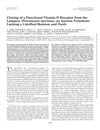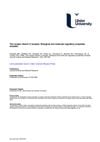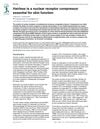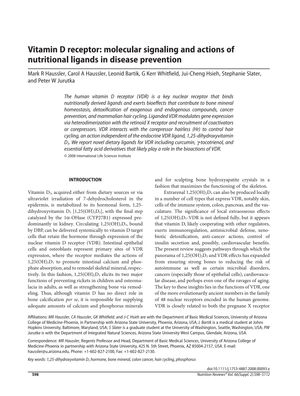TLDR Vitamin D receptor interacts with certain dietary components to help prevent diseases and regulate hair growth.
The document from 2008 discusses the role of the vitamin D receptor (VDR) in various biological processes, including maintaining bone mineral balance, detoxification, cancer prevention, and regulating hair growth. It explains that VDR functions by binding with dietary ligands and influencing gene expression through its interaction with the retinoid X receptor and various coactivators or corepressors. Specifically, VDR's interaction with the corepressor hairless (Hr) is noted to be crucial for hair cycling, and this function is independent of the VDR's endocrine ligand, 1,25-dihydroxyvitamin D(3). Additionally, the document identifies new dietary ligands for VDR, such as curcumin, gamma-tocotrienol, and derivatives of essential fatty acids, suggesting these compounds may be important for VDR's biological actions.
137 citations
,
December 2007 in “Journal of bone and mineral research” Vitamin D and its receptor are crucial for bone health and can be influenced by certain fats and curcumin.
 42 citations
,
July 2007 in “Journal of Biological Chemistry”
42 citations
,
July 2007 in “Journal of Biological Chemistry” Most Hairless gene mutations reduce its ability to work with the Vitamin D Receptor, which might explain a certain type of hair loss.
143 citations
,
May 2007 in “Proceedings of the National Academy of Sciences” Vitamin D receptor is crucial for normal hair growth and preventing hair loss.
78 citations
,
November 2005 in “Endocrinology” Hairless protein can block vitamin D activation in skin cells.
 137 citations
,
September 2005 in “Proceedings of the National Academy of Sciences of the United States of America”
137 citations
,
September 2005 in “Proceedings of the National Academy of Sciences of the United States of America” The HR protein helps hair grow by blocking a hair growth inhibitor, aiding in hair follicle regeneration.
144 citations
,
December 2004 in “Molecular Endocrinology” The vitamin D receptor is essential for normal hair growth, even without its usual binding.
215 citations
,
September 2003 in “Journal of Biological Chemistry” Vitamin D receptor and hairless protein are essential for hair growth.
 104 citations
,
May 2003 in “Endocrinology”
104 citations
,
May 2003 in “Endocrinology” Lampreys have a functional vitamin D receptor that may help detoxify harmful substances.
303 citations
,
October 2000 in “Nature” RXRα is crucial for hair growth and skin cell function.
 1308 citations
,
March 1998 in “Journal of bone and mineral research”
1308 citations
,
March 1998 in “Journal of bone and mineral research” The vitamin D receptor is crucial for bone health and affects various body systems, with mutations potentially leading to disease.
 30 citations
,
January 2009 in “Nuclear Receptor Signaling”
30 citations
,
January 2009 in “Nuclear Receptor Signaling” Hairless protein is crucial for healthy skin and hair, and its malfunction can cause hair loss.






